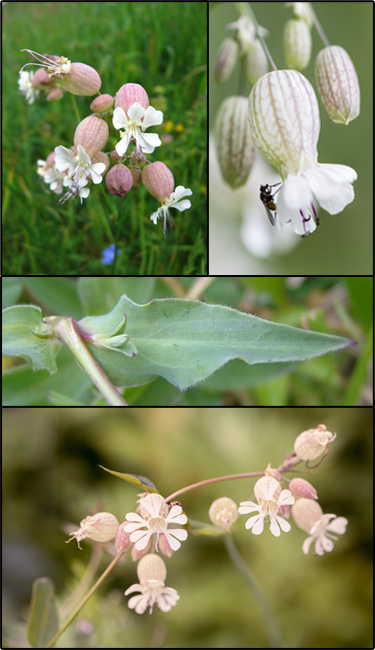Bladder campion (Silene vulgaris)
 Synonyms: Silene latifolia ssp. alba, Silene alba, Silene pratensis
Synonyms: Silene latifolia ssp. alba, Silene alba, Silene pratensisCommon Names: Evening lychnis, white campion, white cockle, maidenstears
Description: Introduced to North America as an ornamental.
Habit: Short-lived perennial, glabrous, rarely pubescent, glaucous, taproot is fleshy & stout, caudex woody, 8-24 in tall, thick lateral roots.
Leaves: Mainly cauline, 2 per node, sessile, almost clasping, reduced proximal to inflorescence, blade broadly oblong to oblanceolate or lanceolate, rarely linear, 2-8 cm by 5-30 mm, round base, apex acute to acuminate.
Stems: Several-many; erect; branched and decumbent at base; rarely simple; 20-80 cm.
Flowers: White in color, bisexual and unisexual, 15-20 mm diameter, margins dentate, lobes broadly triangular. Calyx is pale green to dull pink in color.
Fruit and seeds: Seeds are black, globose-reniform, 1-1.5 mm, finely tuberculate.
Habitat: Native to Africa, Asia and Europe.
Reproduction: By seed.
Similar species: Nightflowering silene (Silene noctiflora); Evening campion (Silene nivea).
Monitoring and rapid response: Hand-pulling for small infestations, making sure all fragments are removed; effectively controlled using any of the several readily available general use herbicides. Credits: The information provided in this factsheet was gathered from the University of Florida Institute of Food and Agriculture Sciences and the USDA PLANTS Database.
Individual species images that appear with a number in a black box are courtesy of the Bugwood.org network (http://www.invasive.org).Individual photo author credits may not be included due to the small display size of the images and subsequent difficulty of reading the provided text. All other images appear courtesy of Google (https://images.google.com).
Common Name: | Bladder campion |
Scientific Name: | Silene vulgaris |
Family: | Caryophyllaceae (Pink) |
Duration: | Perennial |
Habit: | Herbs |
USDA Symbol: | SIVU |
